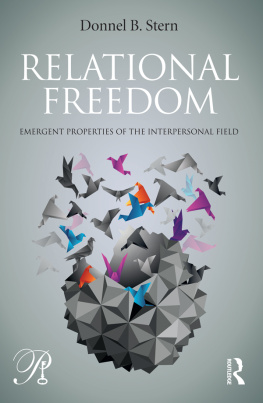Donnel B. Stern - Relational Freedom: Emergent Properties of the Interpersonal Field
Here you can read online Donnel B. Stern - Relational Freedom: Emergent Properties of the Interpersonal Field full text of the book (entire story) in english for free. Download pdf and epub, get meaning, cover and reviews about this ebook. year: 2015, publisher: Routledge, genre: Religion. Description of the work, (preface) as well as reviews are available. Best literature library LitArk.com created for fans of good reading and offers a wide selection of genres:
Romance novel
Science fiction
Adventure
Detective
Science
History
Home and family
Prose
Art
Politics
Computer
Non-fiction
Religion
Business
Children
Humor
Choose a favorite category and find really read worthwhile books. Enjoy immersion in the world of imagination, feel the emotions of the characters or learn something new for yourself, make an fascinating discovery.
- Book:Relational Freedom: Emergent Properties of the Interpersonal Field
- Author:
- Publisher:Routledge
- Genre:
- Year:2015
- Rating:4 / 5
- Favourites:Add to favourites
- Your mark:
Relational Freedom: Emergent Properties of the Interpersonal Field: summary, description and annotation
We offer to read an annotation, description, summary or preface (depends on what the author of the book "Relational Freedom: Emergent Properties of the Interpersonal Field" wrote himself). If you haven't found the necessary information about the book — write in the comments, we will try to find it.
Relational Freedom: Emergent Properties of the Interpersonal Field addresses the interpersonal field in clinical psychoanalysis and psychotherapy, especially the emergent qualities of the field. The book builds on the foundation of unformulated experience, dissociation, and enactment defined and explored in Sterns previous, widely read books.
Stern never considers the analyst or the patient alone; all clinical events take place between them and involve them both. Their conscious and unconscious conduct and experience are the fields substance. We can say that the changing nature of the field determines the experience that patient and analyst can create in one anothers presence; but we can also say that the therapeutic dyad, simply by doing their work together, ceaselessly configures and reconfigures the field. Relational freedom is Sterns own interpersonal and relational conception of the field, which he compares, along with other varieties of interpersonal/relational field theory, to the work of Bionian field theorists such as Madeleine and Willy Baranger, and Antonino Ferro. Other chapters concern the role of the field in accessing the frozen experience of trauma, in creating theories of therapeutic technique, evaluating quantitative psychotherapy research, evaluating the utility of the concept of unconscious phantasy, treating the hard-to-engage patient, and in devising the ideal psychoanalytic institute.
Relational Freedom is a clear, authoritative, and impassioned statement of the current state of interpersonal and relational psychoanalytic theory and clinical thinking. It will interest anyone who wants to stay up to date with current developments in American psychoanalysis, and for those newer to the field it will serve as an introduction to many of the important questions in contemporary psychoanalysis. Psychoanalysts and psychotherapists of all kinds will profit from the books thoughtful discussions of clinical problems and quandaries.
Donnel B. Stern, Ph.D.., a psychoanalyst and psychotherapist in private practice in New York City, serves as Training and Supervising Analyst at the William Alanson White Institute, and Adjunct Clinical Professor and Consultant at the NYU Postodoctoral Program in Psychotherapy and Psychoanalysis. He is the founder and editor of Psychoanalysis in a New Key, a book series published by Routledge.
Donnel B. Stern: author's other books
Who wrote Relational Freedom: Emergent Properties of the Interpersonal Field? Find out the surname, the name of the author of the book and a list of all author's works by series.












